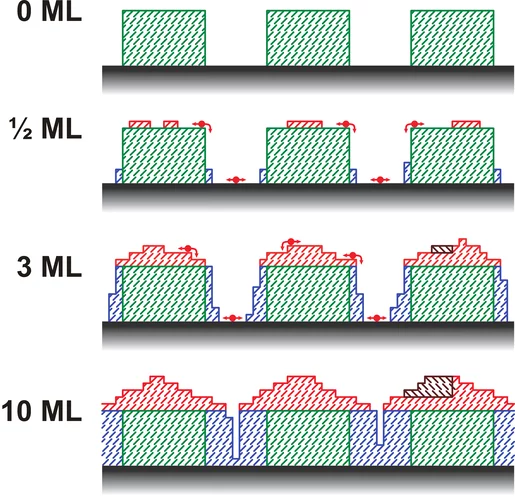Creation and deletion of isolated magnetic skyrmions via electrical currents
The writing and deletion of magnetic Skyrmions is a fundamental step towards the fabrication of memory devices based on this promising spin configuration. Researchers at the Korea Institute of Technology have demonstrated the writing and deleting of isolated magnetic Skyrmions at room temperature in ferrimagnetic multilayer superlattice stacks using electrical currents.
Fresnel Zone Plates with Zone Widths below 10 nm
The spot size of a Fresnel Zone Plate lens is mainly determined by the zone widths of its outermost zone. It is therefore essential to fabricate zone plates with structures as small as possible for high-resolution X-ray microscopy. Researchers at the Laboratory for Micro- and Nanotechnology at the PSI have now developed Fresnel zone plates with zone widths well below 10 nm, down to 6.4 nm. These lenses are capable of pushing resolution in X-ray microscopy to the single-digit regime.
Magnetic structures take a new turn
The unexpected finding that in an ‘artificial spin ice’ magnetostatic energy can be transformed into directed rotation of magnetization provides fresh insights into such nano-patterned magnetic structures — and might enable novel applications in nanoscale devices.
Time- and spatially-resolved magnetization dynamics driven by spin-orbit torques
Current-induced spin-orbit torques hold a great potential for manipulation of magnetization at ultrafast timescales. Researchers at ETH Zürich have demonstrated, using time-resolved STXM imaging at the Swiss Light Source, the influence of spin-orbit torques on the switching behaviour of Pt/Co/AlOx nanostructured elements.
Highly Crystalline C8-BTBT Thin-Film Transistors by Lateral Homo-Epitaxial Growth on Printed Templates
Highly crystalline thin films of organic semiconductors offer great potential for high-performance, low-cost flexible electronics. Researchers at IMEC Belgium have developed a new double-step thin film fabrication process that offers higher performance devices. Soft X-ray spectro-microscopy at the Swiss Light Source was used to prove that the increased performance comes from larger areas of material sharing the same molecular orientation.
Additive Nanofabrication with Focused X-rays
Metal nanostructures can be fabricated by irradiation of suitable metal organic precursor molecules with a focused X-ray beam. This novel techniques offer the advantage of energy-selective deposition by switching of the incident photon energy due to the non-linear photon absorption cross-section of the precursor molecules for resonant excitation.
A Mini-Antenna for the Data Processing of Tomorrow
The use of spin-wave signals in future information processing devices can substantially reduce power consumption over present charge current based technologies. As part of an international research venture, scientists at PSI now introduced a concept to generate spin waves with nanoscale wavelengths exploiting the driven dynamics of magnetic vortex cores in magnetic heterostructures.
La 3D, au nanomètre près
Des chercheurs de l'Institut Paul Scherrer et de l'ETH Zurich ont créé des images en 3D de minuscules objets, et ont même réussi à visualiser au niveau de ces derniers des détails de 25 nanomètres (1 nanomètre = 1 million de millimètre). En plus de déterminer la forme de leurs objets d'étude, ils ont pu également mettre en évidence la façon dont un élément chimique donné (le cobalt) était réparti au sein de ces derniers, tout en étant capables d'établir si ce même élément était présent sous forme de liaison chimique ou sous forme pure.







